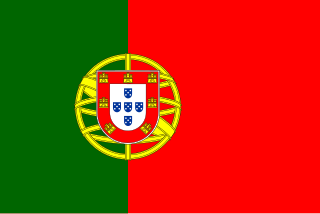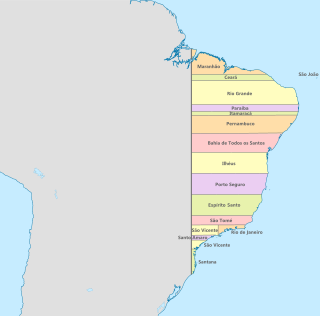Related Research Articles

Portuguese Mozambique or Portuguese East Africa were the common terms by which Mozambique was designated during the period in which it was a Portuguese colony. Portuguese Mozambique originally constituted a string of Portuguese possessions along the south-east African coast, and later became a unified colony, which now forms the Republic of Mozambique.

The Atlantic slave trade or transatlantic slave trade involved the transportation by slave traders of enslaved African people, mainly to the Americas. The outfitted European slave ships of the slave trade regularly used the triangular trade route and its Middle Passage, and existed from the 16th to the 19th centuries. The vast majority of those who were transported in the transatlantic slave trade were from Central and West Africa who had been sold by West African slave traders mainly to Portuguese, British, Spanish, Dutch, and French slave traders, while others had been captured directly by the slave traders in coastal raids; European slave traders gathered and imprisoned the enslaved at forts on the African coast and then brought them to the Americas. Except for the Portuguese, European slave traders generally did not participate in the raids because life expectancy for Europeans in sub-Saharan Africa was less than one year during the period of the slave trade.

Slavery in the colonial history of the United States refers to the institution of slavery as it existed in the European colonies which eventually became part of the United States. In these colonies, slavery developed due to a combination of factors, primarily the labour demands for establishing and maintaining European colonies, which had resulted in the Atlantic slave trade. Slavery existed in every European colony in the Americas during the early modern period, and both Africans and indigenous peoples were victims of enslavement by European colonizers during the era.

Colonial Brazil comprises the period from 1500, with the arrival of the Portuguese, until 1815, when Brazil was elevated to a kingdom in union with Portugal. During the 300 years of Brazilian colonial history, the main economic activities of the territory were based first on brazilwood extraction, which gave the territory its name; sugar production ; and finally on gold and diamond mining. Slaves, especially those brought from Africa, provided most of the workforce of the Brazilian export economy after a brief initial period of Indigenous slavery to cut brazilwood.

A quilombo is a Brazilian hinterland settlement founded by people of African origin, and others sometimes called Carabali. Most of the inhabitants of quilombos, called quilombolas, were maroons, a term for escaped slaves.

The Angolan War of Independence, known as the Luta Armada de Libertação Nacional in Angola, began as an uprising against forced cultivation of cotton and evolved into a multi-faction struggle for control of Portugal's overseas province of Angola among three nationalist movements and a separatist movement. The war ended when a peaceful coup in Lisbon in April 1974 overthrew Portugal's Estado Novo dictatorship and the new regime immediately stopped all military action in the African colonies, declaring its intention to grant them independence without delay.

Slavery in the Spanish American colonies was an economic and social institution which existed throughout the Spanish Empire including Spain itself. Indigenous peoples were enslaved and their populations decimated. Subsequently enslaved Africans were brought over. Native people were also subjected to forced conversions and conscription.

Henrique Carlos da Mata Galvão was a Portuguese military officer, writer and politician. He was initially a supporter but later become one of the strongest opponents of the Portuguese Estado Novo under António de Oliveira Salazar.

The Portuguese Colonial War, also known in Portugal as the Overseas War or in the former colonies as the War of Liberation, and also known as the Angolan, Guinea-Bissau and Mozambican War of Independence, was a 13-year-long conflict fought between Portugal's military and the emerging nationalist movements in Portugal's African colonies between 1961 and 1974. The Portuguese regime at the time, the Estado Novo, was overthrown by a military coup in 1974, and the change in government brought the conflict to an end. The war was a decisive ideological struggle in Lusophone Africa, surrounding nations, and mainland Portugal.
Lusotropicalism is a term and "quasi-theory" developed by Brazilian sociologist Gilberto Freyre to describe the distinctive character of Portuguese imperialism overseas, proposing that the Portuguese were better colonizers than other European nations.

Slavery in Brazil began long before the first Portuguese settlement. Later, colonists were heavily dependent on indigenous labor during the initial phases of settlement to maintain the subsistence economy, and natives were often captured by expeditions of bandeirantes. The importation of African slaves began midway through the 16th century, but the enslavement of indigenous peoples continued well into the 17th and 18th centuries. Europeans and Chinese were also enslaved.
The colonial history of Angola is usually considered to run from the appearance of the Portuguese under Diogo Cão in 1482 (Congo) or 1484 until the independence of Angola in November 1975. Settlement did not begin until Novais's establishment of São Paulo de Loanda (Luanda) in 1575, however, and the Portuguese government only formally incorporated Angola as a colony in 1655 or on May 12, 1886.
Angola in the 1950s transitioned from colonial to provincial status. Angola had the status of a Portuguese colony from 1655 until the Assembly of the Republic passed a law on June 11, 1951, giving all Portuguese colonies provincial status, effective on October 20, 1951. Separatist political organizations advocating Angolan independence formed in the 1950s despite strong resistance from the Portuguese government, leading to the Angolan War of Independence (1961–1975).
The strike in Baixa do Cassange, also called Mariano's revolt and Maria's war, was a labor strike that is considered the first political movement that would trigger the Angolan War of Independence exactly one month later and the Portuguese Colonial War over the next three years in the Portuguese overseas provinces. The uprising began on 4 January 1961 in the region of Baixa do Cassanje, district of Malanje, Portuguese Angola. By the following day, the Portuguese authorities had successfully suppressed the revolt. 4 January is now Colonial Martyrs Repression Day, a national holiday in Angola.

Slavery in Angola existed since the late 15th century when Portugal established contacts with the peoples living in what is the Northwest of the present country, and founded several trade posts on the coast. A number of those peoples, like the Imbangala and the Mbundu, were active slave traders for centuries. In the late 16th century, Kingdom of Portugal's explorers founded the fortified settlement of Luanda, and later on minor trade posts and forts on the Cuanza River as well as on the Atlantic coast southwards until Benguela. The main component of their trading activities consisted in a heavy involvement in the Atlantic slave trade. Slave trafficking was abolished in 1836 by the Portuguese authorities.
In the 1930s in Angola the Portuguese colonial government of António de Oliveira Salazar cut spending on colonization, leading to less emigration to Angola and a decline in the population of Portuguese Angolans.

Slavery among Native Americans in the United States includes slavery by and enslavement of Native Americans roughly within what is currently the United States of America.

Portuguese Angola refers to Angola during the historic period when it was a colony of the Portuguese Empire (1575–1951) in southwestern Africa, an Overseas Province of the Portugal orPortuguese West Africa, then a State of the Portuguese Empire (1972–1975).

Slavery in Latin America was an economic and social institution that existed in Latin America before the colonial era until its legal abolition in the newly independent states during the 19th century. However, it continued illegally in some regions into the 20th century. Slavery in Latin America began in the pre-colonial period when indigenous civilizations, including the Maya and Aztec, enslaved captives taken in war. After the conquest of Latin America by the Spanish and Portuguese, of the nearly 12 million slaves that were shipped across the Atlantic, over 4 million enslaved Africans were brought to Latin America. Roughly 3.5 million of those slaves were brought to Brazil.

Slavery was practiced in Colombia from the beginning of the 16th century until its definitive abolition in 1851. This process consisted of trafficking in people of African and indigenous origin, first by the European colonizers from Spain and later by the commercial elites of the Republic of New Granada, the country that contained what is present-day Colombia.
References
- 1 2 Walker, John Frederick (2004). A Certain Curve of Horn: The Hundred-Year Quest for the Giant Sable Antelope . pp. 100–101.
- ↑ Mullen, J. Atticus Ryan; Christopher A. Mullen (1997). Unrepresented Nations & Peoples Organization, Yearbook 1997. p. 57.
- ↑ Wright, George (1997). The Destruction of a Nation: United States Policy Towards Angola Since 1945 . pp. 2, 8–11, and 57.
- ↑ Oyebade, Adebayo O (2006). Culture And Customs of Angola. pp. XI.
- ↑ Africa Year Book and Who's who. 1977. p. 238.
- ↑ Tvedten, Inge (1997). Angola: Struggle for Peace and Reconstruction . pp. 29–36.
- ↑ Gann, Lewis Henry; Peter Duignan (1973). Colonialism in Africa, 1870-1960. p. 28.
- ↑ Sellström, Tor (1999). Sweden and national liberation in Southern Africa. Vol. 1, Formation of a popular opinion (1950-1970). Uppsala: Nordiska Afrikainstitutet. p. 378. ISBN 91-7106-430-3.